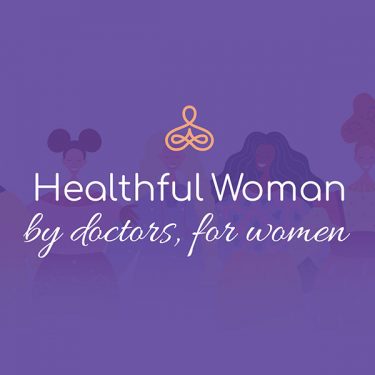There are different types of concerns that can arise when performing genetic testing; to use an analogy, there could be large paragraphs of text that accidentally repeat themselves, which alters the meaning of a chapter in a book, or there could be single letter changes in important sentences that change the meaning of an important thought. Our geneticist, Dr. Tamar Goldwaser, talks today about those latter changes: single gene mutations, and how we are able to detect them during pregnancy.
“CVS and Amniocentesis: What are the various genetic tests we can send? – Part 2” – with Dr. Tamar Goldwaser
Share this post:
Dr. Fox: Welcome to today’s episode of Healthful Woman, a podcast designed to explore topics in women’s health at all stages of life. I’m your host, Dr. Nathan Fox, an OB-GYN and maternal fetal medicine specialist practicing in New York City. In Healthful Woman, I speak with leaders in the field to help you learn more about women’s health, pregnancy and wellness. So now let’s talk about single gene mutation. What exactly are we talking about here?
Dr. Goldwaser: So to use your encyclopedia analogy, I would say a single gene mutation would be a one letter change or a spelling error in one of the sentences, in one of the key important sentences, in a key important chapter. So, chromosomes are huge, and there’s a lot of DNA in them. And some sections of the chromosome are called genes and they code for proteins or enzymes that work in our bodies. And then there’s a lot of DNA in between the genes called introns. And that part of the DNA is also important, but it doesn’t make a gene or a product that we know of, but they are important in how the DNA axon folds and unfolds, or twists and untwists. So a single gene is really zoomed down on a very high magnification level and we sequence a gene, right? So sequencing of a gene would be looking at every single letter, or every single base pair that makes up that gene and we look at the sequence and look to see if there is a letter swapped or a letter missing, or if the gene is short, or has something interrupting it. The end, then we look up in a database to see if that change in the sequence is going to be pathogenic, meaning disease-causing or it’s going to interfere with the function of the gene product. Or if it’s a benign finding, or if it’s, again, variants of uncertain significance.
Dr. Fox: Right now, I agree that the level of discerning is the equivalent to saying in the encyclopedias, you know, go to the Q book, and look in the, you know, quail section, and in the third paragraph, second line, third word, you know, the word tree, make sure there’s a T there and not a W, right, because that’s a known problem. And so, the important part is, the lab would never be able to do that, unless you’ve told them to. Meaning it’s not something that they can just like, currently, randomly just screen you for, say, “Okay, I’m gonna check for all of these things.” Because you have to like, literally go and specifically look at a part of the DNA and zoom in on it and you know, code, it’s like a whole thing. And so the only time people really get these tested, is if they’re at risk for one of these things. And these are the things we’re like specific diseases like all of the ones that might be on a carrier screen, you know, the 500-plus conditions like cystic fibrosis, like Tay-Sachs, like Canavan’s, you know, like sickle cell, right? If you want the lab to check the amnio or CVS for those conditions, it’s not a checkbox, please check all of them. It is you have to tell them, “Please look for this specific condition in this sample.” So they can check for either a known mutation that the couple of carries, or for say, “Hey, look at this entire gene, because it runs in their family, but we don’t really know what the mutation is, and look at that whole gene, and make sure that it’s sort of tip top, and it’s normal versus any variants. And I think that’s really an important part of this, that it has to be known in advance that someone’s at risk for it in order for the lab to test for it.
Dr. Goldwaser: Yeah, I think that’s a very, very good point. And we know, you and I know that we offer and put forth a lot of genetic testing options to pregnant patients, and it feels like it’s all part of the same thing. But they’re all slightly different. So this is why carrier screening in the prenatal setting is not in place of amniocentesis or CVS or screening for Down syndrome and aneuploidy, but it’s complementary, right? So if you are having a baby or planning to have a baby, then you would want to do your carrier screening to see if you have inherited a mutation in one of any of the genes on the panel. And if your partner also has a mutation in the same gene, then we would tell them, there’s specific risks and maybe one in four a chance that they would have a baby with that condition.
So, if you know that you’re a carrier, or a couple, which is a couple that’s at risk of having a child with a mutation, or a clinically significant condition in their offspring, then they would come to us and say, “Okay, we want to do an amniocentesis, and we want to check the fetus to see if they inherited one of our mutations or both of our mutations.” And if it’s both, then we would tell them okay, this fetus is predicted to be affected by the condition. So an example of Tay-Sachs, let’s say they’re both…both the mom and dad are carriers or the people in the couple are both carriers for Tay-Sachs, they’re both healthy individuals because they only have one copy of a mutation and the other gene that they have is normal. So, then we would check the fetus and the fetus can either have inherited both of the mutations from the parents. So then we would say this fetus is predicted to be affected and have Tay-Sachs disease, or we might end up learning, we looked at that gene, and actually, the fetus just inherited one mutation. So the fetus is a carrier, or maybe didn’t inherit it at all.
But you would never learn about the Tay-Sachs gene status by doing a karyotype, chromosome analysis, or microarray because both of those tests are way too bird’s eye view or zoomed out. And we would have to say to the lab, we want you to look at this gene, and look for these mutations or sequence the entire gene, and then they would tell us. So another good example is in ultrasound, in the prenatal ultrasound unit, if we see certain findings like bright intestines, let’s say, and we might think, okay, this is sometimes found in babies with cystic fibrosis, we might say we want to sequence the cystic fibrosis gene from start to finish. So we have to ask specifically, when you’re talking on the gene level, which is a very, very small segment of DNA, you have to ask specifically for that gene to be looked at.
Dr. Fox: Yeah, I find that there’s really three circumstances where someone is going to have testing on the gene level, like for single gene mutation. The first, which is probably the most common that you mentioned is, we know from carrier screening, that the couple is at risk for either something inherited recessively, potentially something on the X chromosome like Fragile X, or maybe even dominant, but we know from screening the parents that there’s a risk of their offspring having that mutation. So we tell the lab to check. So that’s one reason. The second reason, like you said is there’s certain ultrasound findings that might clue us in to an increased risk of a specific disease, or a specific set of diseases or a problem with specific gene or certain genes and we’ll say, okay, because of this finding, please look for this condition, or please look on this gene, or whatever it might be. Again, we’ve to tell them specifically. And the third reason is sometimes if there’s like a family history of certain genetic diseases. Even if we haven’t been able to map it out exactly in the parents, sometimes we’ll have a tested on the fetus. Again, that’s probably less common, because usually, it’ll try to get mapped to the parents first. But occasionally that might happen. Those are the three that I can think of. Are there any I’m forgetting that you would check for a single gene, any other pathways to get there?
Dr. Goldwaser: No, I think you’ve covered it. I mean, I’ve had a patient or two who have a, again, remote family history and just for peace of mind want to check for something, even if we’ve already tested the parents and didn’t find it. Let’s say someone had a pregnancy, where, you know, there were ultrasound findings or birth defects or anomalies on the ultrasound, and we did extensive testing on that pregnancy or that child that they had at home and found a genetic cause, right? So let’s say we found a genetic mutation in the child or in the fetus. And then the next step is always that you test the parents to find out if that mutation or genetic change was inherited from one of the parents, or if it was something called de novo, where neither parent has it, but it was a new mutation in that pregnancy. So if it was de novo, then you tell the family, “Listen, there’s a very low chance of this happening again.” But there is this phenomenon called gonadal mosaicism, where there may be some of this genetic mutation hidden only in the cells of the ovaries or sperm. So those are called gonads. And so there’s a less than 1% recurrence risk when you’ve determined that it’s de novo, but we never say it’s zero. So in those cases, some families who’ve been through a lot or who just want to check just for that small chance will do that genetic tests on the pregnancy as well.
Dr. Fox: Okay, so that’s a single gene. Now, there’s also something that I think sometimes people don’t understand exactly what that is. And it’s partially because it’s new, and it’s not run a lot. And that’s called whole exome sequencing, or WES. So what is whole exome sequencing and who might get that?
Dr. Goldwaser: Okay, whole exome sequencing is sequencing every single gene in the patient. So if we’re talking about an amnio or CVS, it’s sequencing every single gene in that fetus. What’s interesting is, as I explained before, there are only certain parts of each chromosome that are considered genes that code for things. And if you take all of the genes put together, it still only accounts for about 1% of all of the DNA in a person, but instead of what we were just talking about, sequencing one gene, whole exome sequencing sequences, 20,000 genes, all of the genes that we have, and it’s a huge test, and the more genes you look at and the more in-depth a genetic test you have, the higher chances there is to find a variant of uncertain significance. So that’s one thing. And whole exome sequencing at this point is actually, in the pediatric world, it’s the standard of care when you’re working up a child who was born with multiple birth defects or with developmental delay, or intellectual disability, the first line test is whole exome sequencing for those children.
And it used to be, not too long ago, maybe even five years ago, the first line test was a microarray. And so in the prenatal world, we always kinda follow what happens in pediatrics, and when microarray became the standard of care, then a few years later, microarray became also part of standard of care when you’re doing prenatal testing on a fetus that has any kind of anomalies in their anatomy. Whole exome hasn’t come into the prenatal world as standard of care, and it’s not universally offered at all. But you can do whole exome on a fetus or on a fetal sample. And the situations where we would consider using whole exome is, let’s say there is an anomaly. Anomaly means a difference in the anatomy that we see on the fetus on ultrasound, that doesn’t appear to be normal. So we would offer that patient standard genetic testing like a karyotype and microarray. And if all that testing comes out normal and doesn’t explain the anomalies that we see on the ultrasound, we may go to a whole exome to try and get an answer for that family. So whole exome can be used in a case where there are multiple anomalies, or more than one organ system that appears to be affected on the ultrasound findings. And another situation is let’s say there’s a family where there’s more than one pregnancy that they’ve had with the same finding and the chromosome analysis and microarray have been normal and have not explained the finding. And whole exome sequencing can also be done on tissue from either an abortion or a miscarriage if, again, if there were a lot of abnormalities that were unexplained by the standard genetic testing that was already finished or completed.
Dr. Fox: Just to be clear, from a technology standpoint, if someone did whole exome sequencing, and their fetus had cystic fibrosis, it would pick it up because since it’s sequencing all the genes, it’s going to sequence the cystic fibrosis gene.
Dr. Goldwaser: Yes.
Dr. Fox: But it’s not intended to be done if you know they’re both carriers of cystic fibrosis, because you wouldn’t have to do the whole exomes, you would just do that specific gene. This is more like, you know, a shotgun approach. Let’s check all the genes because we have no idea what this condition might be, we have no idea what’s going on. It’s not been mapped out, it’s not been discovered. Because if it was discovered, you could say look for this disease, look for this condition, look for this situation. It’s sort of when we don’t know.
I would say that the main two reasons it’s not done so commonly now in the fetal world is number one, it is if we don’t see a lot of abnormalities, so, if the baby looks normal and all the testing is normal, the chance you’re going to find something that’s pathogenic, meaning that’s a true disease versus finding something like you said, is a variant of uncertain significance. That balance is weighed much differently. Many of the things you’re going to find are going to be of uncertain significance and just freak you out. And so the same reason why we don’t check all newborns for a whole exome sequence if they look normal, you wouldn’t check all fetuses. And even in fetuses, where there’s abnormalities, I would say the reason it’s not done as much is because currently, it’s usually not covered by insurance, right? It’s not technically yet the standard of care. So it costs a lot of money to have it done. I mean, in the order of thousands of dollars, not hundreds, like multiple thousands of dollars. And that’s hard, right? You don’t know if it’s gonna, you know, yield anything, you know, let’s say the chances even if a fetus with multiple abnormalities, let’s say picks up, you know, 5% of the time, you’ll find something, you’re paying thousands of dollars and 95% of the time it won’t find something. And so I think that that’s why it’s not used as commonly nowadays. But it is an option for someone with the resources to pay for that. Or sometimes you can get enrolled. There are certain clinical studies where potentially you could have it done without the cost but you don’t typically get the results back as quickly. It could be many months, but it’s out there as a test, but it’s not yet something we do a lot of in the fetal world.
Dr. Goldwaser: Yeah, and you know, definitely enrolling in a study is an option and that’ll be free of charge, but it’s hard because you wait months, even a year, till you may find the results of the study. And so if you’re doing the testing, to help you get prepared or, you know, gather as much information as you can while the pregnancy is still ongoing, being part of a study sometimes just is not gonna help you in that scenario. But the studies are great and there are studies that are recruiting those types of cases. And then even if insurance covers, you know, a lot of times it…since it’s thousands of dollars, and most of these labs are out of network, people end up still having to pay a pretty penny for this type of test. And then the other thing to think about is that there’s a higher chance of getting a variant of uncertain significance, which can be just stressful. But again, we would say well, hold your hand, we’ll get you through that kind of result. Another thing is that with whole exome sequencing, because you’re looking at every gene, there is a potential for incidental findings, which have nothing to do with the case, right? So you…
Because you’re sequencing the genes, you might find that the fetus has inherited a BRCA1 mutation. And so that’s a…if you have that pathogenic mutation in the BRCA1 gene, then you have an inherited predisposition for breast and ovarian cancer. And then the next step after they find that is they can test the parents and then all of a sudden, a mother or father might learn that they have a BRCA1 mutation and now they have to think about breast and ovarian cancer in themselves. And so that’s not a downside, but it’s something that you have to consider when doing such a large test is that you may actually get a diagnosis for the parents themselves.
Dr. Fox: Yeah, it can definitely open up a lot of information, which again, you can spin is a good thing, and you can spin is a bad thing based on how you view sort of genetic testing in general. I mean, you know, you’re a geneticist, I’m a, you know, MFM and so we tend to think of it as good to know these things. But a lot of people don’t, they just don’t want to know. They’re like, “Listen, I’m good,” you know, they’ve no interest.
Dr. Goldwaser: And like, right now I’m thinking about this baby. And this is all I want to know that right now, right.
Dr. Fox: Now there is something called whole genome sequencing. Again, it’s not a test we order, but just to be thorough in terms of what are the possibilities, what is whole genome sequencing?
Dr. Goldwaser: So whole genome sequencing is even bigger, and it sequences all of the DNA. So exome means all of the DNA that codes for genes. And then there are those introns that I talked about. So if you do a whole genome sequencing, you’re not just sequencing the exons that code for genes, but you’re also sequencing all the intervening segments of DNA in between the genes. And that test is available for children and adults, but it’s not available prenatally. So I just think it’s good for context. Because someone might say, did I do the biggest test did I test for everything, like, that’s actually available and possible on a fetus, and we don’t have the ability to do whole genome. And again, the more you look at, the more likely you’re going to find uncertain findings. And if you do a whole genome it would be very, very high chance to find multiple uncertain findings.
And going back the whole exome for a second, whole exome is interpreted in the context of what the clinical scenario is. So the doctors have to submit the sample with a report of all the findings on the patient, so that the people interpreting the results know what to look for. So if it’s a fetus that is normal, you have nothing to say you have nothing for them to focus in on, you can’t say there’s a heart defect or that there’s a learning disability or that there’s blindness or that the kidneys don’t work, you know, there’s just nothing for them to look at. So the more information that the laboratory has on the patient, the better the interpretation of the whole exome that you get. So that’s another reason why whole exome is harder in the prenatal setting, there’s so much that you don’t know that the patient who is the fetus at that time.
Dr. Fox: Yeah, and I think it’s important just to remember, not everyone’s DNA is the same, right? There are things about us that are different, and they’re coded in our DNA. And so, you know, you have to interpret a whole, you know, whether it’s a whole genome sequencing or whole exome sequencing. When you’re looking at it, they can’t just say, oh, that’s abnormal, right? Unless it’s a known condition, right? We know what the mutation would be for cystic fibrosis, there’s a lot of them, and we know a lot of them and so is the art. We know that’s a mutation. But if you just see a difference, like, well, compared to who, right? How do we know, it’s not the difference that makes one person’s you know, hair blonde versus black, or whatever it might be? And so you have to sort of take into context of what is the parents’ DNA, and sort of what is sort of normal variance in the population. And there’s a lot of analysis.
I mean, I remember…it’s so crazy, I remember this…I’m talking about this because it’s so fascinating how far we’ve come, but also the same issues came up when they started the Human Genome Project, right? So what was it like 20 years ago plus, minus? It’s not that long ago, we had not sequenced the human genome really, in enough people. And like, this is brand new in the, you know, in the world of…20 years is not a long time. And when they first start doing it I remember asking, “Well, who’s the standard? “Who’s going to be the gold standard DNA sequence?” Because our DNA is mostly the same. But there’s a lot of differences, and how would you know what’s a normal variant versus something that’s a problem variant? And this is complicated stuff. And we’re learning more and more, but, you know, part of it is just the wonderment of how far we’ve come. But also the idea that when you start opening up a lot of boxes, you know, and just checking everything under the sun, yes, you might find things that you would have never found before, but you also might find things that you really don’t need to find because they’re normal, and they may freak you out. And it’s a hard balance. And that’s why these tests really require significant pre-test conversation and not something you would just say, oh, let’s do this and you check off a box and you send it. Like, I know in our practice, like, we don’t let anyone do whole exome without basically like, having a real serious conversation about it with you basically, right?
Dr. Goldwaser: Yeah.
Dr. Fox: You’re the gatekeeper.
Dr. Goldwaser: Yeah. Yeah, and it’s not because we’d want to stop anyone from gaining information, but you want to guide someone to do a test that’s appropriate for them. And that’s not going to just bring up issues that are irrelevant, or uninterpretable. So you want to help people and we so do want to help people. And sometimes it’s really useful to use the whole exome. And it helps people not just in that pregnancy, but sometimes if you find the cause of the finding, it can help families to plan differently for a future pregnancy, either by doing IVF and testing embryos for the genetic change that was found, or by doing early prenatal diagnosis by CVS to check for that.
Dr. Fox: Yeah. I mean, I find for something like whole exome, the reason it would be very helpful is again, let’s say you have a fetus with multiple abnormalities or baby with multiple abnormalities. And you’re concerned about, A, this baby, obviously, but also the future. If you do this kind of sequencing and find a mutation, and you see that it’s not present in the parents, number one, you sort of, okay, this seems to be the reason of the problem. And number two, since it’s not in the parents, the likelihood that a future child would have it is not 25% 50%, it’s like you said, somewhere, zero to 1%, right? It’s either 0%. Or if there’s that sort of odd thing about having it, you know, just in the sperm or the egg cell line, it’s less than 1%. But basically, it’s close to zero. Whereas if you find the mutation, and then you find, oh, the parents are carriers of this, then, A, you’ve discovered something new, but, B, they know that it’s 25% every pregnancy and they can decide, I’m not gonna get pregnant, or I’m gonna do IVF and test the embryos, or I’m going to do, you know, an early CVS to find out if this next baby has it. Maybe they have options. And it’s…
Dr. Goldwaser: Yeah and even an egg donor, sperm donor, right. Exactly.
Dr. Fox: Yeah. And that’s a huge difference when you find out, hey, like, this is the story, and you’re not really at risk for it again, versus, hey, this is the story and you are at risk for it again. So it has a huge implication for future pregnancies as well. And that’s, you know, sometimes people ask, well, what’s a difference? My baby has a condition already, like, why do I need to know what it is, it really could have significant implications for future pregnancies. And I think most of the things we find, are not things that the parents carry, because those usually have been mapped out already because they’ve run in families or whatever. But you know, we are discovering new ones all the time. And so it could be either, in theory,
Dr. Goldwaser: The human genome, where we’ve mapped it out where there’s like a basic backbone structure that all humans share. And then we have a ton of differences, even single nucleotide polymorphisms, like these one little letter change, that just make us who we are different and individuals and wonderful variety of human beings, you know. So like, even when we have lots of lots of differences, and most of them would be considered benign, and some are known based on experience and in lab they’ll set up models of these mutations to see how they work in a laboratory or in a mouse model, or in a petri dish. And there are lots of different ways to test mutations in the laboratory or in animals or, again, like just by observing what has happened in patients and what’s been reported in the literature. This is how we define whether a mutation or genetic change is harmful or benign, or that middle category. And I just also want to say that if something is called a variant of uncertain significance, the goal in the genetics community is for it not to stay in that category for a long time. So there are lots of people, the NIH has a big database called ClinVar and people work on these variants. And they comb literature and look for case report and look for people studying these genetic variants, so that we can clear out that bucket of variants of uncertain significance and provide more clarity for patients as the years go on.
Dr. Fox: Yeah. It is amazing that if you look at the DNA, and like you said, there’s, you know, if you look at 100%, only about 1% of it is the genes. And the differences between us…there are differences in the DNA that make us different, you know, in terms of our appearance, risk for disease, obviously maybe even personality traits and whatnot. But there’s there. But the amazing thing is how common the DNA is among species. Amongst humans, you know, 99-plus percent of it is the same as everyone else’s even, you know, the amount that we share with most primates is almost exactly the same. And it’s someone told me yeah, and I think we have 90%, the same DNA as a banana. And it’s like, it’s really crazy, you know, how much of it is similar amongst life forms. And it’s just those little tiny differences in that little tiny percent of the DNA that makes everything so varied in the world. It’s really just fascinating, and how we’re learning about this and how much we’re learning. It’s crazy.
Dr. Goldwaser: So true.
Dr. Fox: Mind-blowing. So just as a review, if someone is considering an amnio or CVS, the main levels we spoke about are the karyotype. Again, that’s sort of the look at all the encyclopedias, the microarray is looking for some about 100 pages here and there, are others missing, you know, amongst a whole set? Then the mutation of a single gene is looking for a specific letter that’s changed, or maybe gene sequencing is saying, all right, read this entire paragraph on this page and make sure every letter is okay. And then a whole exome is basically taking the, you know, several thousand paragraphs over the course of the whole set of books and reading each of those. These are the tests you would be considering for amnio or CVS, if it’s sort of more of a routine, whole exome really wouldn’t be on the table or would just be the karyotype the microarray. If you have a family or personal history or carriers, then the mutations come into line and if there’s an abnormal finding in ultrasound, and we have to discuss which of these you might get.
Tamar, always the best. Thanks for coming on.
Dr. Goldwaser: Of course, we’re putting out the word.
Dr. Fox: All right, we’ll have you again.
Dr. Goldwaser: So good. Thanks. so much.
Dr. Fox: Thank you for listening to the Healthful Woman Podcast. To learn more about our podcast, please visit our website at www.healthfulwoman.com. That’s healthfulwoman.com. If you have any questions about this podcast or any other topic you would like us to address please feel free to email us at hw@healthful woman.com. Have a great day. The information discussed in Healthful Woman is intended for educational uses only. It does not replace medical care from your physician. Healthful Woman is meant to expand your knowledge of women’s health and does not replace ongoing care from your regular physician or gynecologist. We encourage you to speak with your doctor about specific diagnoses and treatment options for an effective treatment plan. Paid sponsors of the podcast are not involved in the creation of the podcast or any of the content. Support for our sponsors should not be interpreted as medical advice from the podcast, the host or the guests.








